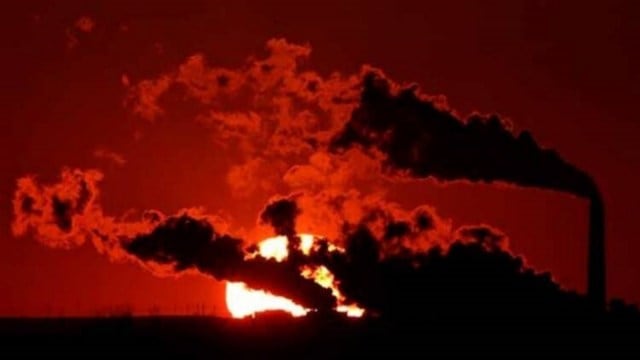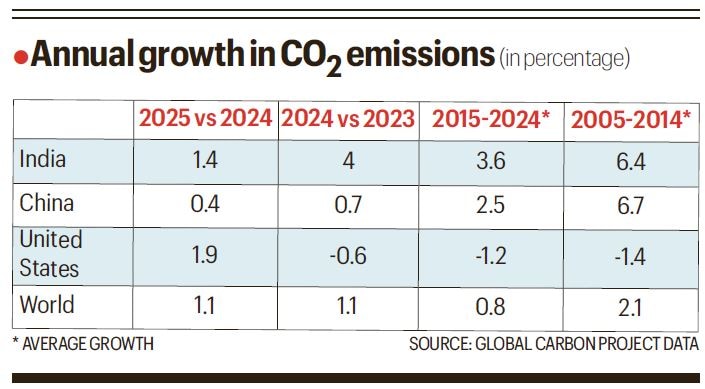ARTICLE AD BOX
 India’s fossil fuel-related emissions in 2024 were 3.19 billion tonnes of CO2 equivalent and they are estimated to increase to 3.22 billion tonnes this year, according to the annual Global Carbon Budget study carried out by this project.
India’s fossil fuel-related emissions in 2024 were 3.19 billion tonnes of CO2 equivalent and they are estimated to increase to 3.22 billion tonnes this year, according to the annual Global Carbon Budget study carried out by this project.
India’s carbon dioxide emissions from fossil fuel sources are expected to increase by just about 1.4% in 2025, significantly lower than the 4% growth registered the previous year, new data released by Global Carbon Project (GCP) shows.
India’s fossil fuel-related emissions in 2024 were 3.19 billion tonnes of CO2 equivalent and they are estimated to increase to 3.22 billion tonnes this year, according to the annual Global Carbon Budget study carried out by this project.
The relatively modest growth in India’s emissions this year was lower than even the United States whose emissions are expected to increase by 1.9%, possibly attributable to the climate-denialist policies of the Donald Trump administration.
Story continues below this ad
“An early monsoon reduced cooling requirements in the hottest months (in India). Combined with strong growth in renewables, this led to very low growth in coal consumption,” a statement accompanying the study said.
Fossil-related CO2 emissions cover a wide range of sectors, including electricity generation, transportation, industrial processes, buildings and heating. These account for about 90% of all CO2 emissions globally. The remaining 10% come primarily from land-use changes like deforestation and degradation of natural ecosystems.
CO2 emissions account for about 75% of global greenhouse gas emissions. Other significant greenhouse gases are methane, nitrous oxide and some fluorinated compounds.

The GCP is an international collaborative programme that tracks global carbon cycles and emissions. It carries out the Global Carbon Budget study every year, which is published in the Nature journal and is timed to coincide with the annual climate conference COP30 currently being held in Brazil.
Story continues below this ad
These are estimates and not official emission data for the countries, but happen to be one of the most reliable and keenly-tracked. The official numbers are prepared and submitted by countries themselves, with rigorous sectoral data collection requiring several years of work.
The latest GCP study shows that the growth of India’s CO2 emissions has slowed down not just this year. It has gone down even on the decadal scale. The average annual growth of India’s emissions in the current decade (2015-2024) was 3.6% compared to 6.4% in the 2005-2014 period, the study shows. This could be a result of an expanding base effect as well as continuous improvements in carbon intensity of India’s economy.
A separate analysis, done by Centre for Research on Energy and Clean Air for Carbon Brief, a UK-based climate-focused publication, a couple of months ago had revealed that for the first time, CO2 emissions from India’s electricity sector in the first half of this year had shown a decline compared to the same period last year. This too was attributed to good monsoon rainfall resulting in lower demands for cooling and irrigation.
CO2 emissions from fossil fuels were expected to rise globally by about 1.1% to reach a record 38.1 billion tonnes this year, once again underscoring the fact that years of climate action had still not been able to force a decline in emissions. The GCP study said CO2 emissions from land-use changes were expected to decline this year, helping the overall CO2 emissions to remain relatively flat (about 42 billion tonnes) compared to last year.










 English (US) ·
English (US) ·